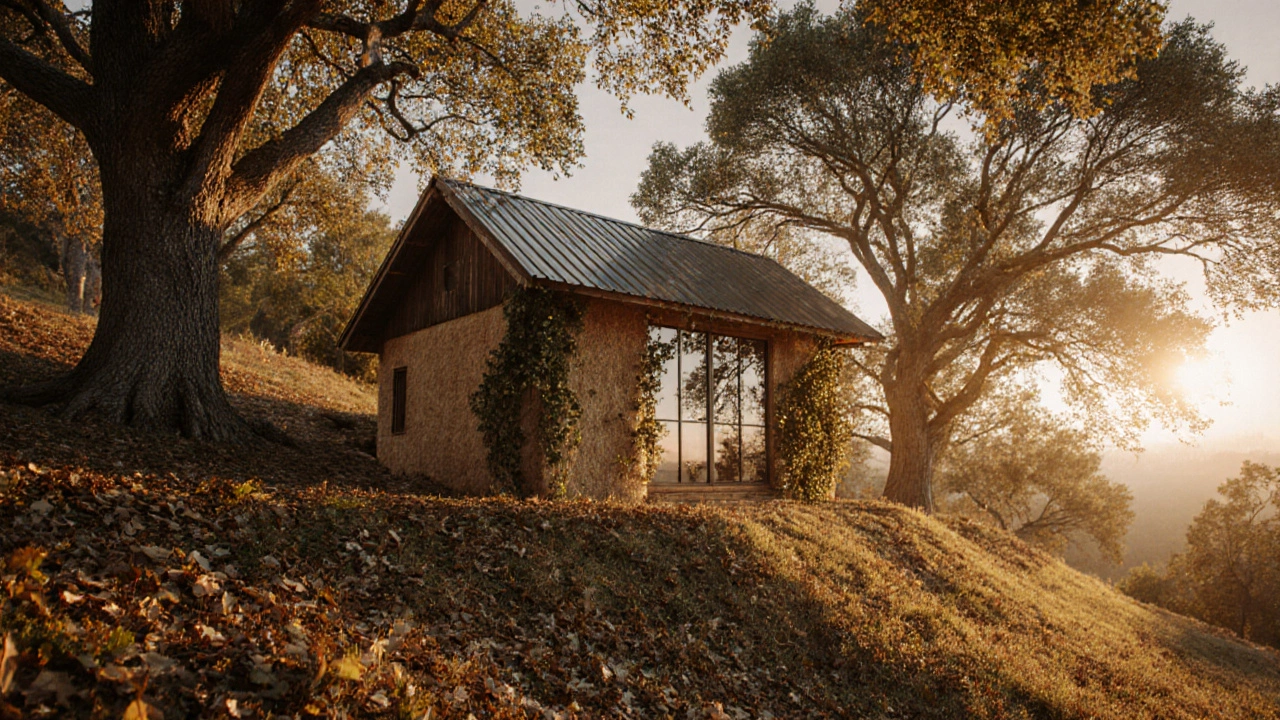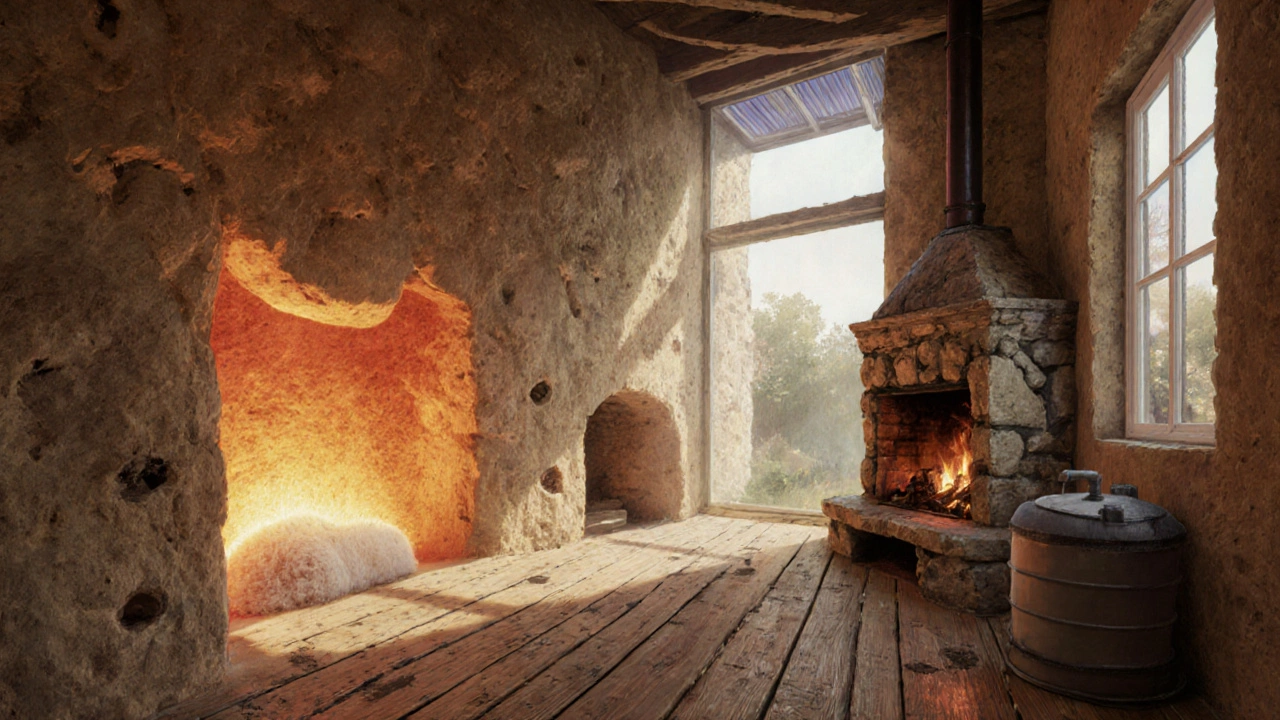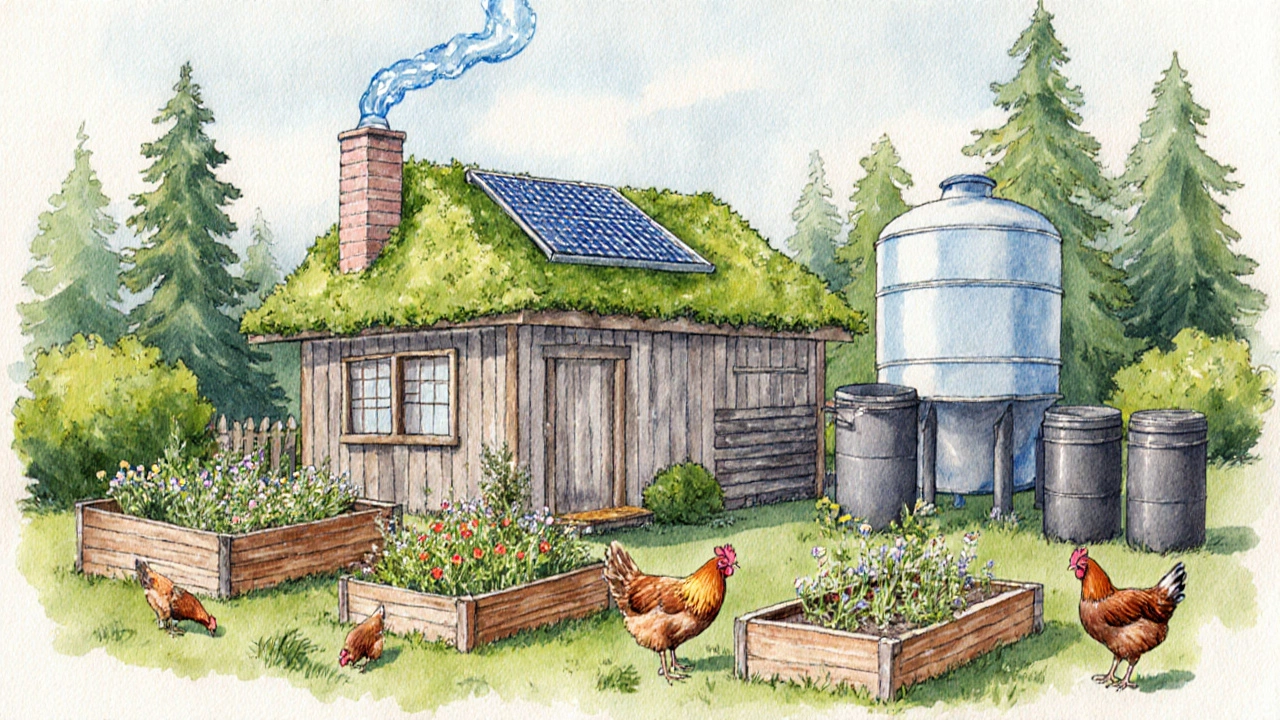How to Build an Eco-Friendly Cottage: Practical Steps for Sustainable Living
 Nov, 6 2025
Nov, 6 2025
Eco-Friendly Cottage Cost Calculator
Calculate Your Sustainable Cottage Savings
Estimate your upfront costs versus conventional building and potential savings over time based on your choices.
Building an eco-friendly cottage isn’t just about using recycled wood or installing solar panels. It’s about designing a space that lives lightly on the land, uses minimal energy, and supports the environment instead of draining it. Too many people think sustainability means expensive tech or perfect conditions. The truth? You can build a truly green cottage with smart choices, even on a modest budget - if you know where to start.
Start with the Site, Not the Blueprint
Where you build matters more than what you build. A poorly chosen spot can force you into energy-hungry fixes later. Look for land that already has some natural advantages: a south-facing slope in the northern hemisphere catches sunlight year-round. Trees on the north side act as windbreaks. Avoid clearing mature trees unless absolutely necessary - they’re natural air conditioners and carbon sinks.
Check the soil. Clay-heavy ground holds water and can cause foundation issues. Sandy soil drains too fast, making it hard to grow food or maintain moisture. Loamy soil is ideal. If you’re building in a forested area, work around existing trees instead of removing them. One homeowner in Vermont kept 12 mature oaks and built their cottage between them. The trees shade the house in summer and drop leaves that naturally fertilize the soil.
Choose Natural, Local Materials
Concrete and steel have massive carbon footprints. Skip them if you can. Instead, look to materials already in your region. Straw bales, reclaimed timber, bamboo, rammed earth, and hempcrete are all proven options. Straw bale walls, for example, have an R-value of around 40 - higher than most standard walls - and they’re made from agricultural waste.
Reclaimed wood from old barns, factories, or even demolished homes is a great choice. It’s already seasoned, so it won’t warp or crack like new lumber. One couple in Maine built their entire cottage using wood salvaged from a 19th-century mill. The floors still show nail holes and saw marks - and they cost 60% less than new pine.
For insulation, avoid fiberglass. Opt for cellulose (recycled newspaper treated with borax) or sheep’s wool. Both trap heat better, are non-toxic, and come from renewable sources. Sheep’s wool insulation even absorbs moisture and reduces indoor air pollutants.
Design for Passive Heating and Cooling
You don’t need a fancy HVAC system if your design works with nature. Large, double-glazed windows on the south side let in winter sun. Overhangs or deciduous vines above those windows block summer heat. Thermal mass - like a concrete floor or stone wall - absorbs heat during the day and releases it slowly at night.
One cottage in Colorado uses a 6-inch thick rammed earth wall inside the living room. In winter, it warms up from sunlight and keeps the room comfortable without any heater. In summer, the same wall stays cool, pulling heat out of the air.
Don’t forget ventilation. A well-placed window on the opposite side of the house creates cross-breezes. A roof vent or solar chimney pulls hot air out naturally. In hot climates, a green roof (plants on the roof) can lower indoor temperatures by up to 30°F.

Go Off-Grid Smartly
Being off-grid doesn’t mean living in the dark. Solar panels are the most common choice, but they’re not the only one. A small wind turbine works well in windy areas. Micro-hydro systems can power a cottage if you have a flowing stream nearby - some systems generate 500 watts from just a trickle of water.
Pair solar with lithium-ion batteries. Lead-acid batteries are cheaper but last half as long and are heavier. A 5kWh lithium system can power lights, a fridge, a water pump, and a small stove for days without sun. One family in Oregon runs their entire off-grid cottage on 3.5kWh of solar and a single 5kWh battery. They use LED lights, a 12V fridge, and a propane stove for cooking - cutting energy needs by 70%.
Water is just as important. Rainwater harvesting is simple: gutters channel water into a 2,000-gallon tank. Filter it through a sand and charcoal system, then use it for showers and laundry. For drinking, add a UV purifier. Graywater systems reuse water from sinks and showers to irrigate gardens - no chemicals needed.
Build for Longevity, Not Trends
A green cottage isn’t green if it falls apart in 10 years. Build to last. Use metal roofs - they last 50+ years, are 100% recyclable, and shed snow easily. Avoid vinyl siding. It’s petroleum-based and breaks down into microplastics.
Windows should be triple-glazed with low-emissivity coating. They’re pricier upfront, but they cut heating bills by 40%. Doors should be solid wood with proper weather stripping. Even small leaks waste energy.
Plan for repairs. Install access panels behind walls for plumbing and wiring. Don’t bury pipes under concrete. Use modular systems so you can replace one part without tearing down the whole house. One builder in New Hampshire uses removable wall panels made from recycled plastic. If a pipe bursts, they just unclip the panel - no drywall dust, no demolition.
Live With the Land, Not Against It
Your cottage should feed you, not just shelter you. Grow food. Even a small garden with raised beds made from reclaimed wood can produce herbs, tomatoes, and kale. Compost kitchen scraps. Use black soldier fly larvae to turn food waste into protein for chickens - they eat scraps and lay eggs.
Install a chicken coop. Two hens can provide eggs and natural fertilizer. Chickens also control insects. One cottage in Vermont has 4 chickens and grows 80% of its vegetables. They don’t need a greenhouse - just cold-hardy varieties like kale, carrots, and potatoes.
Use native plants around the cottage. They don’t need watering, fertilizers, or pesticides. Wildflowers attract bees. Evergreen shrubs provide winter cover for birds. A natural yard doesn’t look messy - it looks alive.

What to Avoid
Don’t fall for greenwashing. Some companies sell “eco-friendly” products that are just plastic with a leaf sticker. Check certifications: FSC for wood, Cradle to Cradle for materials, Energy Star for appliances. Avoid products with VOCs (volatile organic compounds) - they pollute indoor air.
Don’t overbuild. A 1,200-square-foot cottage is more sustainable than a 3,000-square-foot one. Smaller spaces use less energy, less material, and cost less to maintain. Focus on quality, not size.
Don’t ignore maintenance. A green cottage needs regular care: cleaning gutters, checking seals, pruning vines, testing water filters. Neglect turns sustainability into a liability.
Real Cost, Real Savings
Building an eco-friendly cottage costs 10-20% more upfront than a standard one. But the savings add up. A typical off-grid cottage in the U.S. spends $500 a year on energy. A conventional cabin spends $2,000. Water bills drop to near zero. Maintenance costs fall because natural materials last longer.
One couple in Montana spent $140,000 on their 900-square-foot cottage. They saved $1,800 in the first year on energy and water. In five years, they broke even. Now, they’re saving $1,500 a year - and growing their own food.
Government grants and tax credits exist in many states for renewable energy and insulation. Check local programs - some offer up to $10,000 in rebates.
Final Thought: It’s Not Perfect - It’s Progress
No cottage is 100% perfect. Maybe you can’t source all materials locally. Maybe your roof isn’t solar-ready yet. That’s okay. Start with one change. Swap one appliance. Add one window. Plant one tree. Build one wall with reclaimed wood. Each step adds up.
An eco-friendly cottage isn’t about being flawless. It’s about choosing, every day, to live with less harm. And that’s something anyone can do - no matter the budget, no matter the location.
What’s the cheapest way to build an eco-friendly cottage?
The cheapest way is to use reclaimed materials and design a small, simple structure. Salvaged wood, recycled metal roofing, and straw bale insulation can cut material costs by 30-50%. Skip central heating and use a wood stove instead. Build in phases - start with the core living space and add rooms later. One family in Washington built their entire cottage for under $60,000 using mostly donated or found materials.
Can you build an eco-friendly cottage in a cold climate?
Yes, and cold climates often make passive solar design even more effective. Thick insulation (like sheep’s wool or cellulose), triple-glazed windows, and thermal mass (stone or concrete floors) retain heat. A well-sealed cottage in northern Minnesota stays warm with just a wood stove and sunlight. Avoid aluminum frames - they conduct cold. Use wood or fiberglass windows instead.
Do you need a permit to build an eco-friendly cottage?
Yes, most places require building permits, even for small structures. Some rural areas allow structures under 100-200 square feet without a permit, but plumbing, electrical, and septic systems still need approval. Check with your local building department. Many now have green building codes that reward energy-efficient designs with faster approvals.
How long does it take to build an eco-friendly cottage?
A simple 800-1,000 sq ft cottage can be built in 4-6 months with a small team. Using prefab components like straw bale panels or SIPs (structural insulated panels) speeds things up. If you’re doing most of the work yourself, expect 8-12 months. Planning and sourcing materials often take longer than construction.
Are eco-friendly cottages more resistant to fire or pests?
Some materials are naturally resistant. Rammed earth and stone don’t burn. Straw bales, when tightly packed and plastered with clay or lime, resist fire better than drywall. Hempcrete is non-toxic and repels mold and pests. Termites avoid lime-based plasters. However, wood framing still needs protection - use borate-treated lumber or metal shields at the base.